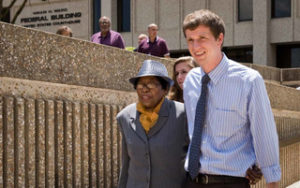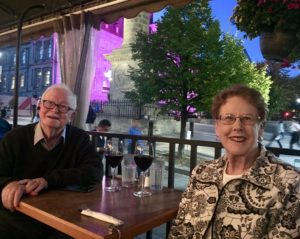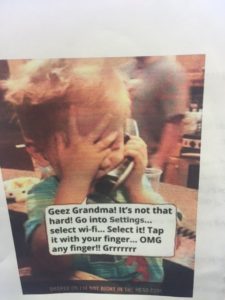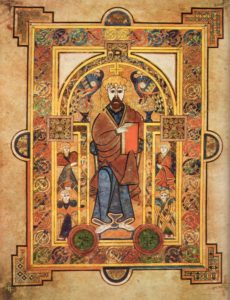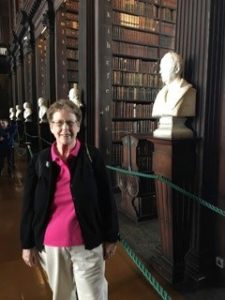When I think of Civil Rights, my mind immediately goes to voting rights, the 15th Amendment* and the Voting Rights Bill of 1965.** I remember how people marched, protested and died to push President Johnson, Congress and their congressmen and senators to pass this bill. In other words, I think of the past. This has all been discussed and litigated and it’s over.
In the last few years I’ve been unpleasantly surprised to find out that I’ve been wrong. Voting rights are not in the past, they are now. It’s a fight that’s still going on.
Today I attended a lecture titled “Bringing Dignity Back to Voting in the Robert’s Court”. The speaker was Ellen D. Katz. She is a Law Professor at the University of Michigan in Ann Arbor. Her expertise is writing about and teaching election law, civil rights and their remedies, as well as equal protection.
While she was being introduced I focused on the word dignity. It’s not a word we often use. What is it really? I like this definition: Dignity is “the state or quality of being worthy of honor or respect”.***
Dr. Katz’s point was that dignity is intrinsic to the right to vote. It’s a central component because being disenfranchised is humiliating and degrading. It is the opposite of being worthy of honor or respect.
Professor Katz gave a number of examples from history:
- There was Carter Glass who introduced the Poll Tax in Virginia in 1902. He said its purpose was to discriminate so as to eliminate every Negro voter that it could. He felt Black Suffrage needed to be blocked because it bestowed dignity on African-American men.
- Then there were the opponents of Women’s Suffrage. Many of them said that enfranchising women would decrease the dignity of men and therefore should be opposed.
- In 1965, President Johnson, speaking in support of the Voting Rights Act, said to Congress, “I speak tonight for the dignity of man and the destiny of democracy…”.
John Roberts became Chief Justice in September, 2005. From then to now there have been massive cutbacks in the reach of the Voting Rights Act. For example, in Crawford v. Merion County, Justice John Paul Stevens upheld Indiana’s Voter I.D. Law while at the same time acknowledging that 43% of Indiana citizens at that time did not have proper Voter I.D.s and thus would lose their right to vote. He also noted that there had never been a case of voter fraud in Indiana–ever. The Voter I.D. law was a remedy for a problem that did not exist. But more importantly, by disenfranchising almost half of Indiana voters he took away their dignity as citizens.
In 2014 there were a series of lower court decisions that spoke of Voter I.D. laws as being problematic. At the time the Supreme Court stayed these decisions. This meant it ruled to halt further legal process in these trials or other legal proceeding.****
Two years passed and things changed dramatically. In 2016, lower court after lower court ruled in favor of the plaintiffs. One of the best known cases is that of 94 year old Rosanell Eaton of North Carolina.*****She had been voting since 1942 when she’d had to ride a mule to town. Once there, she had to pass a Literacy Test before she was allowed to vote. But the new 2013 North Carolina Voter I.D. law disenfranchised her because her birth certificate said Rosanell Eaton and her Driver’s License said Rosanell Johnson Eaton. This whole experience took away her dignity.
In order to keep her right to vote, this 94 year old woman, who had voted in every election since 1942, had to make 11 trips to various government agencies. To do this, she had to travel over 200 miles. At 94, it was very difficult and expensive for her as well as humilating. After all, she had voted in every election since 1942.
At the time, over 300,000 other citizens of North Carolina did not have the correct Voter I.D. and the majority of them were African-American. How many of them wouldn’t be able to do this? This law was taking away their dignity as citizens.
The Fourth Circuit Court in Richmond found the North Carolina law unconstitutional and said that North Carolina had acted with “intentional racial discrimination” and “surgical precision” to deny voters the ability to vote “without hindrance”.
So what’s dignity got to do with it? Because you’re a citizen you have a right to vote. When, because of your color or sex, you’re denied this right, you don’t feel worthy of honor and respect. You feel humiliated and degraded. You realize you’re being told you’re not as good as those other people who are citizens just like you, but they’re entitled to vote.
That’s what dignity has to do with it!
*The 15th Amendment to the Constitution granted African American men the right to vote by declaring that the “right of citizens of the United States to vote shall not be denied or abridged by the United States or by any state on account of race, color, or previous condition of servitude.”
https://www.google.com/#q=what+is+the+15th+amendment
**Voting Rights Act – Black History – HISTORY.com The Voting Rights Act, signed into law by President Lyndon Johnson (1908-73) on August 6, 1965, aimed to overcome legal barriers at the state and local levels that prevented African Americans from exercising their right to vote under the 15th Amendment (1870) to the Constitution of the United States.
www.history.com/topics/black-history/voting-rights-act
*** https://www.google.com/#q=+of+dignity
****Stay of Proceedings – Wikipedia
https://en.wikipedia.org/wiki/Stay_of_proceedings
